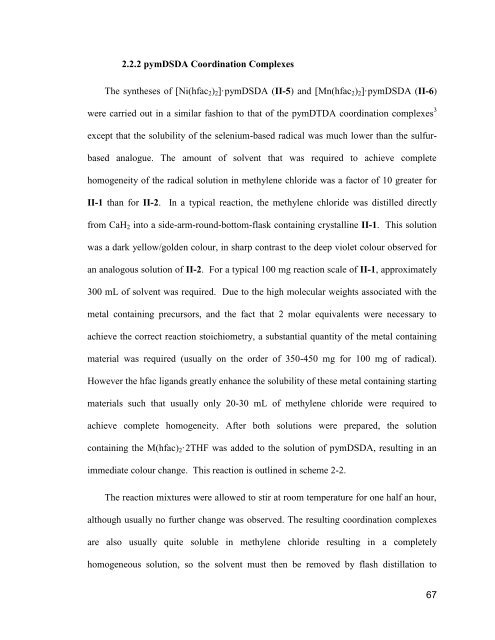1,2,3-Dithiazolyl and 1,2,35-Dithiadiazolyl Radicals as Spin-Bearing ...
1,2,3-Dithiazolyl and 1,2,35-Dithiadiazolyl Radicals as Spin-Bearing ...
1,2,3-Dithiazolyl and 1,2,35-Dithiadiazolyl Radicals as Spin-Bearing ...
Create successful ePaper yourself
Turn your PDF publications into a flip-book with our unique Google optimized e-Paper software.
2.2.2 pymDSDA Coordination Complexes<br />
The syntheses of [Ni(hfac 2 ) 2 ]·pymDSDA (II-5) <strong>and</strong> [Mn(hfac 2 ) 2 ]·pymDSDA (II-6)<br />
were carried out in a similar f<strong>as</strong>hion to that of the pymDTDA coordination complexes 3<br />
except that the solubility of the selenium-b<strong>as</strong>ed radical w<strong>as</strong> much lower than the sulfurb<strong>as</strong>ed<br />
analogue. The amount of solvent that w<strong>as</strong> required to achieve complete<br />
homogeneity of the radical solution in methylene chloride w<strong>as</strong> a factor of 10 greater for<br />
II-1 than for II-2. In a typical reaction, the methylene chloride w<strong>as</strong> distilled directly<br />
from CaH 2 into a side-arm-round-bottom-fl<strong>as</strong>k containing crystalline II-1. This solution<br />
w<strong>as</strong> a dark yellow/golden colour, in sharp contr<strong>as</strong>t to the deep violet colour observed for<br />
an analogous solution of II-2. For a typical 100 mg reaction scale of II-1, approximately<br />
300 mL of solvent w<strong>as</strong> required. Due to the high molecular weights <strong>as</strong>sociated with the<br />
metal containing precursors, <strong>and</strong> the fact that 2 molar equivalents were necessary to<br />
achieve the correct reaction stoichiometry, a substantial quantity of the metal containing<br />
material w<strong>as</strong> required (usually on the order of <strong>35</strong>0-450 mg for 100 mg of radical).<br />
However the hfac lig<strong>and</strong>s greatly enhance the solubility of these metal containing starting<br />
materials such that usually only 20-30 mL of methylene chloride were required to<br />
achieve complete homogeneity. After both solutions were prepared, the solution<br />
containing the M(hfac) 2·2THF w<strong>as</strong> added to the solution of pymDSDA, resulting in an<br />
immediate colour change. This reaction is outlined in scheme 2-2.<br />
The reaction mixtures were allowed to stir at room temperature for one half an hour,<br />
although usually no further change w<strong>as</strong> observed. The resulting coordination complexes<br />
are also usually quite soluble in methylene chloride resulting in a completely<br />
homogeneous solution, so the solvent must then be removed by fl<strong>as</strong>h distillation to<br />
67

















